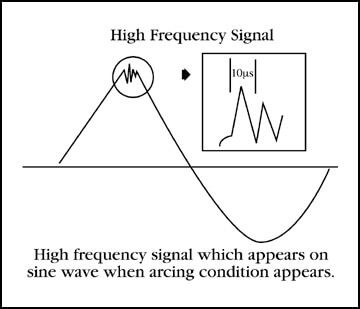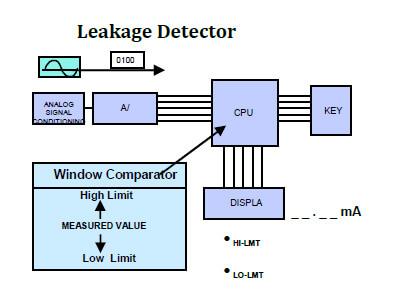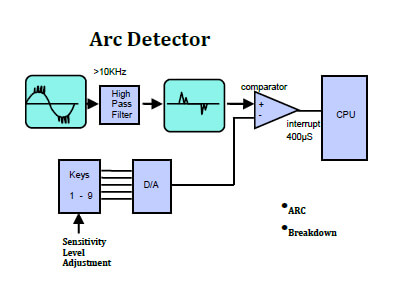The Truth About Arc Detection
Introduction
With the ever-increasing list of features and options available for instruments in the field of test and measurement it is getting more challenging to select the appropriate device for the job. One feature that has caused substantial confusion within the industry is arc detection technology, which is often added to the dielectric withstand test (commonly referred to as the hipot test). Ever since this technology’s inception there has been wide speculation surrounding arc detection, mostly due to the varying definitions and inconsistent claims made by hipot manufacturers.
Although Associated Research has offered hipots equipped with arc detection circuitry since 1996, many customers are still confused about this feature. When should arc detection be used? What are the benefits of arc detection? Are there any potential problems associated with arc detection? How does AR’s arc detection circuitry compare with other manufacturers’ technologies? It seems that there is no limit to the questions regarding this relatively new feature. The purpose of this document is to help clarify the issues regarding arc detection and to provide honest explanations of the benefits and pitfalls of this new technology.
What is Arc Detection?
In order to understand what arc detection is it is first necessary to determine a definition for arcing. Arcing is defined as a momentary partial discharge due to the intense concentration of an electric field (high voltage) across a dielectric. In the case of hipot testing, this dielectric is usually the DUT’s (device under test) insulation. Many times an arcing condition can be seen as a luminous discharge caused by the ionization of air molecules, called corona. Highimpedance arcing is a temporary condition and it is not necessarily considered to be a sign of dielectric breakdown – the condition that a hipot was originally designed to test. Dielectric breakdown causes a massive amount of leakage current to flow through a product’s insulation, while arcing usually produces momentary spikes in the nominal leakage current waveform. Arc detection circuitry was implemented to differentiate between these two conditions.
An investigation into a specific safety agency standard provides us with a practical explanation of the difference between dielectric breakdown and arcing:
IEC 60601-1 Medical Electronic Equipment Section 20.4f states the following: “During the test, no flashover or breakdown shall occur. Slight corona discharges are neglected, provided that they cease when the test voltage is temporarily dropped to a lower value, which must be higher, however, than the reference voltage (U) and provided that the discharges do not provoke a drop in the test voltage.”
As the standard above shows, arcing and corona aren’t necessarily indicative of a dielectric breakdown. However, it is important to keep in mind that in some cases arcing can be an indication of a problem with the DUT’s insulation or the manufacturing process.
| Arcing | Breakdown |
| Temporary condition due to imperfections in the insulation that may be seen as flashover or corona. Causes brief spikes in leakage current measurements. May occur in products that are still electrically safe, depending on testing standard. |
Catastrophic insulation failure condition that becomes evident at lower voltages during each subsequent test. Causes excessive and dangerous amount of leakage current flow. Always the sign of a faulty product that isn’t fit for production or sale. |
So how is an arc detected? High impedance arcs and corona generate high frequency current pulses that ride on the lower frequency wave of the applied test current waveform. These pulses may have a frequency ranging from less than 30 kHz to more than 1 MHz, and may be very short in duration. Many times these pulses last much less than 10 microseconds. AR’s arc detection circuitry consists of a high pass filter circuit that responds only to frequencies that are greater than 10 kHz. These high frequency signals are fed into a comparator and checked against an operator-programmed sensitivity level selected during the test setup. If this level is exceeded, an interrupt signal is fed into the CPU, which shuts down the hipot.


Figure 1: Arcing Condition
It is important to note that the arc detection failure displayed by an AR hipot is separate from the hi-limit failure, which is displayed when dielectric breakdown has occurred.




Figure 2: Two Separate Failure Detectors
Why is Arc Detection Important?
As the above section mentions, an arc causes momentary high frequency current spikes that ride on the low frequency current waveform. Although these current spikes may not necessarily be the result of a catastrophic breakdown of the DUT’s insulation, they could indicate a problem with the insulation system that might become a safety issue at a later date. For instance, sometimes arcing can occur as the result of a series fault condition.
Usually stemming from a manufacturing defect such as a loose connection, a series fault condition creates an arc that is current limited by the impedance of the circuit it is in series with. Since the arc is current limited, this condition will never trigger the hi-limit failure monitored by a standard hipot test, but could create a potential fire hazard. Without arc detection, manufacturers of products with inherent arcing conditions could potentially be passing faulty products or products that may fail prematurely.
AR’s arc detection circuitry allows for the hipot to differentiate between the current spikes caused by an arc’s rate of change of current over time (Δdi/dt), and the excessive leakage current associated with dielectric breakdown. Further, the arc detection circuit allows the test operator to set a distinct sensitivity level corresponding to the arc intensity. If relatively low-level arcing is deemed permissible by the manufacturer of the DUT, the arc detector can be set to a low sensitivity level to allow for arcs of lower magnitude to be neglected while high-level arcs will result in an arc failure condition.
The addition of an adjustable sensitivity level, however, has led to discrepancies between arc detectors of different hipot manufacturers. Many hipot customers have questioned how the results can differ from hipot manufacturer to hipot manufacturer, or even hipot to hipot. We will touch on this later in the document. Despite these discrepancies, the addition of the arc detector to the hipot test does result in a hipot that provides manufacturers with more information about what is happening in their DUT's.
When Should Arc Detection be Used?
From a quality control standpoint, more information is always useful in determining product safety. Perhaps several products have been damaged during shipping, resulting in poor gap spacing between a conductor and the insulation. This condition may not necessarily result in a dielectric breakdown, but with arc detection turned on it would be possible to catch this problem before the faulty products find their way into customers’ hands. Maybe the integrity of a product’s insulation has been weakened during the manufacturing process or a component has become damaged during shipping, and when subjected to a hipot test low-level arcing results. Although the product might pass the hipot test, the arc detector could pick up the arcing condition and produce an arc failure.
Despite the many scenarios in which arc detection can be beneficial, a major source of confusion surrounding the technology is the apparent lack of test standards for using arc detection during a hipot test. There are very few sources of information available to help a manufacturer determine if arc detection is a necessary part of a DUT’s test procedure, and those standards that do exist are relatively subjective. What’s even more puzzling is that there is no specific arcing standard that defines whether or not arcing is acceptable in electrical products, and if so to what degree. Yet cues can be taken from other industries that deal with arcing and arc detection.
The number of specific industries that have recently mandated arc detection as part of quality control and product safety precautions is growing. Arc detection and arc fault circuit breakers have become standard in the airline industry for checking the integrity of wire harnesses on airplanes. Identifying faulty insulation in airplane wire harnesses helps reduce the risk of fire and other electrical problems. As of 2002 the National Electrical Code requires arc fault circuit interrupters (AFCI’s) installed in feeder and branch circuits of residences. These interrupters help to prevent arcing within homes, and need to be tested using some sort of arc detection technology in order to ensure that they are in good working order.
There is one major benefit resulting from the vague standards associated with arc detection: hipots that incorporate the arc detection feature have been refined with regard to operator control. The operator-programmable sensitivity level and the ability to enable or disable the arc detection feature both help to increase the scope of the technology’s benefits. Ultimately it is up to the manufacturer to determine whether or not to use the arc detector, and if so, at what sensitivity level. The flexibility of the technology does provide manufacturers with a choice, and the result is an extra measure of control when performing a hipot test.
Quantifying an Arc
The simple fact is that it is very difficult to accurately measure the current produced by an arc. This is due to the extreme number of variables inherent to an arcing condition. The geometry of an arc is never a constant. For example, breakdown voltages may vary greatly between two rounded surfaces or two sharp points that have the same gap spacing. The impedance and distributed capacitance of the circuits between the point where the arc is generated and the detector may also affect the Δdi/dt of the current waveform being monitored by the arc detector. The amount of voltage, rate of rise, polarity, and the waveform all affect the speed in which corona and arcing conditions occur. Temperature, humidity, and atmospheric pressure all influence the voltage at which corona begins as well as breakdown voltage levels.
Arc Detection Results and Discrepancies
With so many variables involved in the equation, arc detection becomes more of an approximation than a science. Many manufacturers want to know if an arc detection circuit can be setup to measure current at a specific level. While it is possible to setup the circuit with distinct trip levels, the detection results obtained by the hipot may seem very inconsistent. Failure to produce a known repeatable arcing condition leads to an inability for hipot manufacturers to accurately calibrate the arc detection sensitivity scales. In fact, the leakage current inherent to a hipot due to its circuit board traces, input and output transformers, and other components further complicates a hipot manufacturer’s ability to create a universal quantifiable sensitivity scale. An arc that causes a failure on one hipot model might not necessarily induce a failure on another of a different model. The sensitivity scale needs to change as a result of the output impedance of a specific hipot. Therefore, an arc detector sensitivity measurement must be used to approximate arc level intensity, not quantify it. Unfortunately, this approximation of detecting arc intensity is where the majority of hipot manufacturers differ.
AR’s arc detection sensitivity settings are based on a scale of levels 1-9, with 1 being the least sensitive and 9 being the most sensitive. It is important to note that these sensitivity levels only loosely correspond to current levels of 20-2 mA for the very reasons stated above. The arc detection sensitivity levels correspond to an approximation of arc intensity, not a finite current value. AR leaves it up to the manufacturer of the DUT to determine which level is appropriate for testing a product, as there is no official standard available in determining an acceptable arcing level.
Summary
Today’s hipot testers come equipped with a variety of features designed to verify the safety and integrity of electrical products. While the primary purpose of the hipot test is to ensure a product’s insulation system is sufficient enough to prevent against electric shock, most hipot testers come equipped with arc detection circuitry as well. The addition of arc detection circuitry allows for manufacturers to test their products for both dielectric breakdown and arcing conditions during a hipot test.
It is important to note that dielectric breakdown is considered to be a catastrophic failure of the DUT’s insulation system while arcing may or may not be considered a failure condition. In general, arc detection is only an approximate means of monitoring the arcing levels of a DUT due to the inherent variables of an arcing condition. An arc detection failure should be treated as a tool to provide more information about the integrity of an electrical product’s insulation and should not be considered a valid substitute for a dielectric breakdown (excessive leakage current) failure. In some cases, arc detection isn’t necessary for a hipot test, but the option is available to any manufacturer that needs to test for arcing in the insulation of a DUT. Whether testing products that are prone to defects as a result of the manufacturing process, or providing a fail safe test for product liability, arc detection can indeed be a useful tool; however, since there are no major safety agencies that specify arc detection in order to receive a listing, it becomes the manufacturer’s responsibility to determine the value of arc detection for each specific application.




